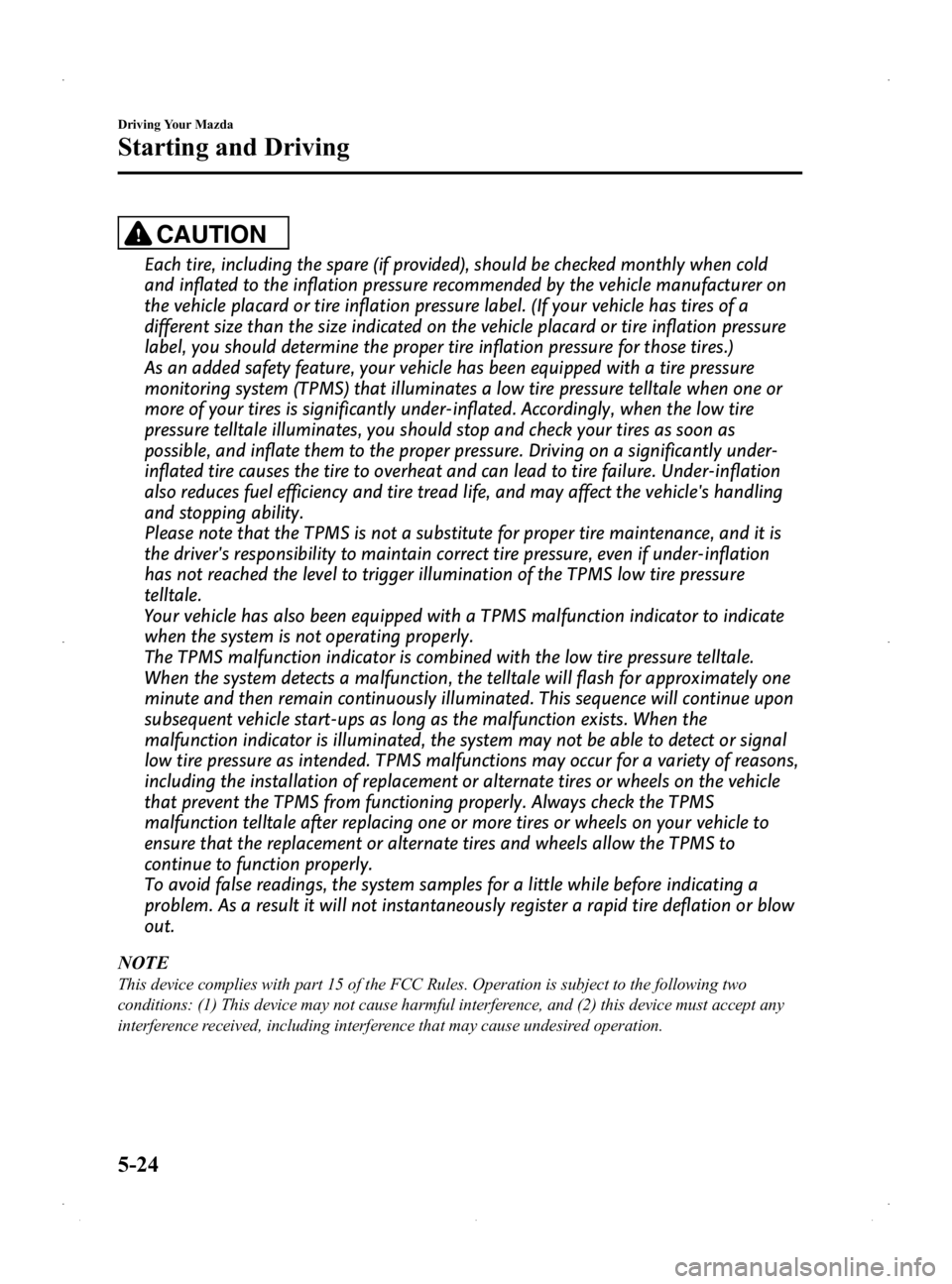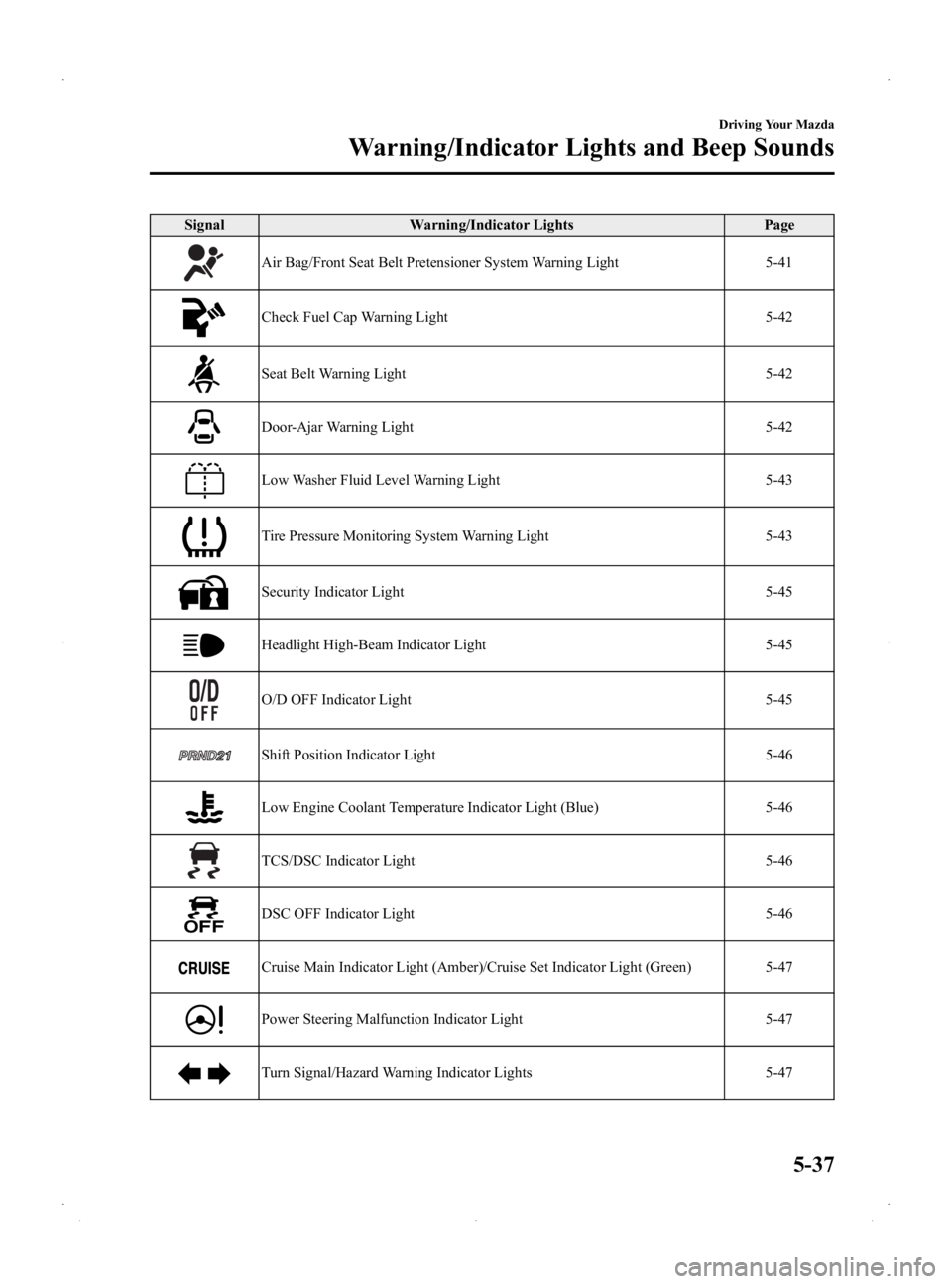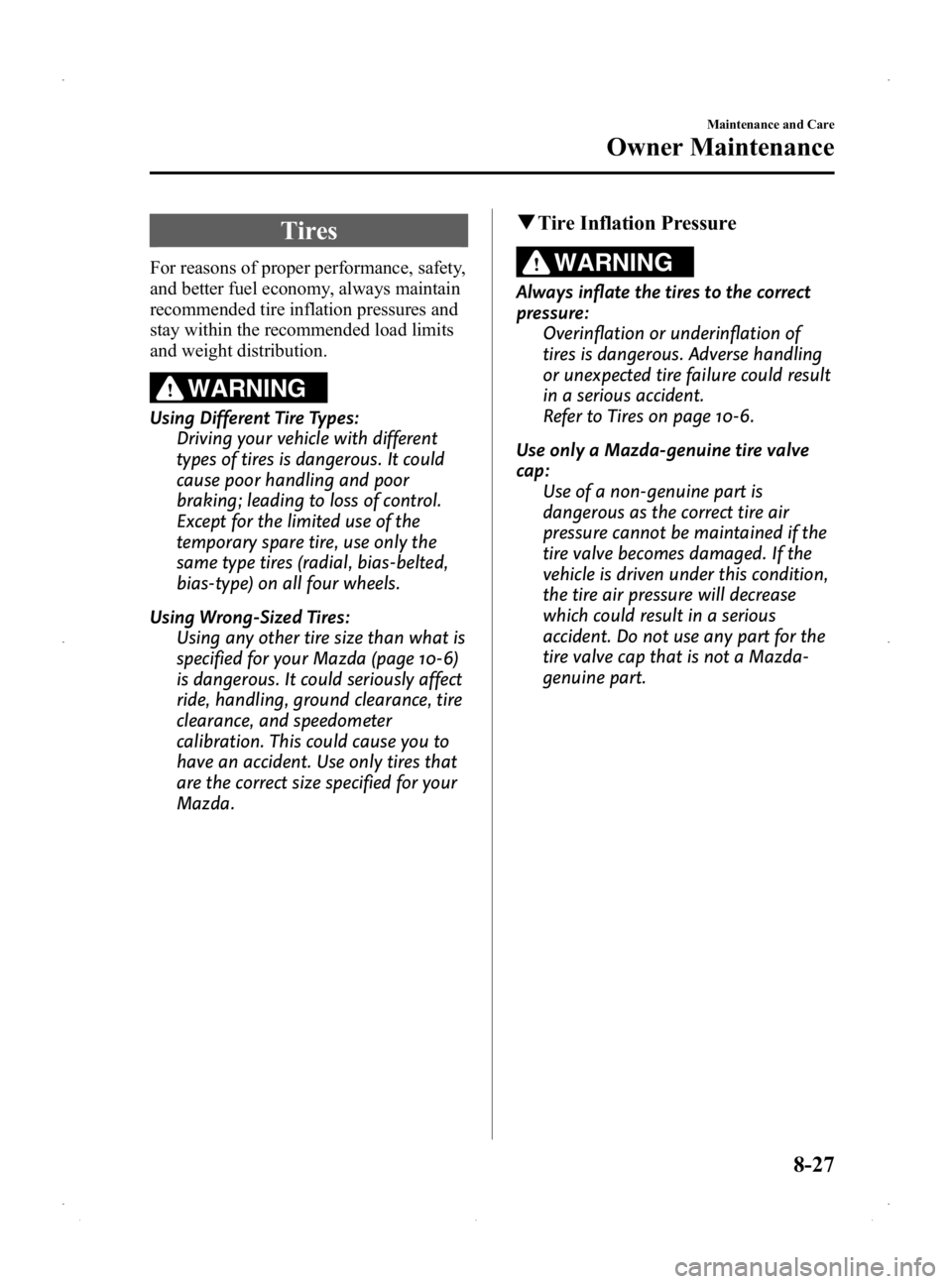fuel pressure MAZDA MODEL 2 2014 Owners Manual
[x] Cancel search | Manufacturer: MAZDA, Model Year: 2014, Model line: MODEL 2, Model: MAZDA MODEL 2 2014Pages: 356, PDF Size: 4.02 MB
Page 86 of 356

Black plate (86,1)
Fuel-Filler Lid and Cap
WARNING
When removing the fuel-filler cap,
loosen the cap slightly and wait for any
hissing to stop. Then remove it:Fuel spray is dangerous. Fuel can
burn skin and eyes and cause illness
if ingested. Fuel spray is released
when there is pressure in the fuel
tank and the fuel-filler cap is
removed too quickly.
Before refueling, stop the engine, and
always keep sparks and flames away
from the filler neck: Fuel vapor is dangerous. It could be
ignited by sparks or flames causing
serious burns and injuries.
Additionally, use of the incorrect fuel-
filler cap or not using a fuel-filler cap
may result in fuel leak, which could
result in serious burns or death in an
accident.
CAUTION
Always use only a genuine Mazda
fuel-filler cap or an approved
equivalent, available at an
Authorized Mazda Dealer. The wrong
cap can result in a serious
malfunction of the fuel and emission
control systems. It may also cause
the check engine light in the
instrument cluster to illuminate.
qFuel-Filler Lid
To open, pull up the remote fuel-filler lid
release.
Remote fuel-
filler lid release
qFuel-Filler Cap
To remove the fuel-filler cap, turn it
counterclockwise.
Attach the removed cap to the inner side
of the fuel lid.
To close the fuel-filler cap, turn it
clockwise until a click is heard.
Open
Close
3-18
Knowing Your Mazda
Doors and Locks
Mazda2_8DB2-EA-13G_Edition4 Page86
Thursday, May 15 2014 1:37 PM
Form No.8DB2-EA-13G
Page 130 of 356

Black plate (130,1)
CAUTION
Each tire, including the spare (if provided), should be checked monthly when cold
and inflated to the inflation pressure recommended by the vehicle manufacturer on
the vehicle placard or tire inflation pressure label. (If your vehicle has tires of a
different size than the size indicated on the vehicle placard or tire inflation pressure
label, you should determine the proper tire inflation pressure for those tires.)
As an added safety feature, your vehicle has been equipped with a tire pressure
monitoring system (TPMS) that illuminates a low tire pressure telltale when one or
more of your tires is significantly under-inflated. Accordingly, when the low tire
pressure telltale illuminates, you should stop and check your tires as soon as
possible, and inflate them to the proper pressure. Driving on a significantly under-
inflated tire causes the tire to overheat and can lead to tire failure. Under-inflation
also reduces fuel efficiency and tire tread life, and may affect the vehicle's handling
and stopping ability.
Please note that the TPMS is not a substitute for proper tire maintenance, and it is
the driver's responsibility to maintain correct tire pressure, even if under-inflation
has not reached the level to trigger illumination of the TPMS low tire pressure
telltale.
Your vehicle has also been equipped with a TPMS malfunction indicator to indicate
when the system is not operating properly.
The TPMS malfunction indicator is combined with the low tire pressure telltale.
When the system detects a malfunction, the telltale will flash for approximately one
minute and then remain continuously illuminated. This sequence will continue upon
subsequent vehicle start-ups as long as the malfunction exists. When the
malfunction indicator is illuminated, the system may not be able to detect or signal
low tire pressure as intended. TPMS malfunctions may occur for a variety of reasons,
including the installation of replacement or alternate tires or wheels on the vehicle
that prevent the TPMS from functioning properly. Always check the TPMS
malfunction telltale after replacing one or more tires or wheels on your vehicle to
ensure that the replacement or alternate tires and wheels allow the TPMS to
continue to function properly.
To avoid false readings, the system samples for a little while before indicating a
problem. As a result it will not instantaneously register a rapid tire deflation or blow
out.
NOTE
This device complies with part 15 of the FCC Rules. Operation is subject to the following two
conditions: (1) This device may not cause harmful interference, and (2) this device must accept any
interference received, including interference that may cause undesired operation.
5-24
Driving Your Mazda
Starting and Driving
Mazda2_8DB2-EA-13G_Edition4 Page130
Thursday, May 15 2014 1:37 PM
Form No.8DB2-EA-13G
Page 143 of 356

Black plate (143,1)
SignalWarning/Indicator Lights Page
Air Bag/Front Seat Belt Pretensioner System Warning Light 5-41
Check Fuel Cap Warning Light5-42
Seat Belt Warning Light5-42
Door-Ajar Warning Light5-42
Low Washer Fluid Level Warning Light5-43
Tire Pressure Monitoring System Warning Light5-43
Security Indicator Light5-45
Headlight High-Beam Indicator Light5-45
O/D OFF Indicator Light5-45
Shift Position Indicator Light5-46
Low Engine Coolant Temperature Indicator Light (Blue) 5-46
TCS/DSC Indicator Light5-46
DSC OFF Indicator Light5-46
Cruise Main Indicator Light (Amber)/Cruise Set Indicator Light (Green) 5-47
Power Steering Malfunction Indicator Light5-47
Turn Signal/Hazard Warning Indicator Lights5-47
Driving Your Mazda
Warning/Indicator Lights and Beep Sounds
5-37
Mazda2_8DB2-EA-13G_Edition4 Page143
Thursday, May 15 2014 1:37 PM
Form No.8DB2-EA-13G
Page 253 of 356

Black plate (253,1)
Owner Maintenance Schedule
The owner or a qualified service technician should make these vehicle inspections at the
indicated intervals to ensure safe and dependable operation.
Bring any problem to the attention of an Authorized Mazda Dealer or qualified service
technician as soon as possible.
qWhen Refueling
lBrake and clutch fluid level (page 8-16)lEngine coolant level (page 8-14)lEngine oil level (page 8-13)lWasher fluid level (page 8-19)
qAt Least Monthly
Tire inflation pressures (page 8-27)
qAt Least Twice a Year (For Example, Every Spring and Fall)
lAutomatic transaxle fluid level (page 8-17)
You can do the following scheduled maintenance items if you have some mechanical
ability and a few basic tools and if you closely follow the directions in this manual.
lEngine coolant (page 8-14)lEngine oil (page 8-13)
Maintenance and Care
Owner Maintenance
8-9
Mazda2_8DB2-EA-13G_Edition4 Page253
Thursday, May 15 2014 1:38 PM
Form No.8DB2-EA-13G
Page 271 of 356

Black plate (271,1)
Tires
For reasons of proper performance, safety,
and better fuel economy, always maintain
recommended tire inflation pressures and
stay within the recommended load limits
and weight distribution.
WARNING
Using Different Tire Types:Driving your vehicle with different
types of tires is dangerous. It could
cause poor handling and poor
braking; leading to loss of control.
Except for the limited use of the
temporary spare tire, use only the
same type tires (radial, bias-belted,
bias-type) on all four wheels.
Using Wrong-Sized Tires: Using any other tire size than what is
specified for your Mazda (page 10-6)
is dangerous. It could seriously affect
ride, handling, ground clearance, tire
clearance, and speedometer
calibration. This could cause you to
have an accident. Use only tires that
are the correct size specified for your
Mazda.
qTire Inflation Pressure
WARNING
Always inflate the tires to the correct
pressure:
Overinflation or underinflation of
tires is dangerous. Adverse handling
or unexpected tire failure could result
in a serious accident.
Refer to Tires on page 10-6.
Use only a Mazda-genuine tire valve
cap: Use of a non-genuine part is
dangerous as the correct tire air
pressure cannot be maintained if the
tire valve becomes damaged. If the
vehicle is driven under this condition,
the tire air pressure will decrease
which could result in a serious
accident. Do not use any part for the
tire valve cap that is not a Mazda-
genuine part.
Maintenance and Care
Owner Maintenance
8-27
Mazda2_8DB2-EA-13G_Edition4 Page271
Thursday, May 15 2014 1:38 PM
Form No.8DB2-EA-13G
Page 272 of 356

Black plate (272,1)
The Tire Pressure Monitoring Systemí
does not alleviate the need to check the
tire condition every day, including
whether the tires all look inflated properly.
Inspect all tire pressure monthly
(including the spare) when the tires are
cold. Maintain recommended pressures
for the best ride, handling, and minimum
tire wear.
When checking the tire pressures, use of a
digital tire pressure gauge is
recommended.
Refer to the specification charts (page
10-6).NOTE
lAlways check tire pressure when tires are
cold.
lWarm tires normally exceed recommended
pressures. Don't release air from warm tires
to adjust the pressure.
lUnderinflation can cause reduced fuel
economy, uneven and accelerated tire wear,
and poor sealing of the tire bead, which
will deform the wheel and cause separation
of tire from rim.
lOverinflation can produce a harsh ride,
uneven and accelerated tire wear, and a
greater possibility of damage from road
hazards.
Keep your tire pressure at the correct
levels. If one frequently needs inflating,
have it inspected.
q
Tire Rotation
WARNING
Rotate tires periodically:
Irregular tire wear is dangerous. To
equalize tread wear for maintaining
good performance in handling and
braking, rotate the tires according to
the scheduled maintenance charts.
Refer to Scheduled Maintenance on
page 8-4.
8-28
Maintenance and Care
íSome models.
Owner Maintenance
Mazda2_8DB2-EA-13G_Edition4 Page272
Thursday, May 15 2014 1:38 PM
Form No.8DB2-EA-13G
Page 294 of 356

Black plate (294,1)
qUnderbody Maintenance
Road chemicals and salt used for ice and
snow removal and solvents used for dust
control may collect on the underbody. If
not removed, they will speed up rusting
and deterioration of such underbody parts
as fuel lines, frame, floor pan, and exhaust
system, even though these parts may be
coated with anti-corrosive material.
Thoroughly flush the underbody and
wheel housings with lukewarm or cold
water at the end of each winter. Try also
to do this every month.
Pay special attention to these areas
because they easily hide mud and dirt. It
will do more harm than good to wet
down the road grime without removing
it.
The lower edges of doors, rocker panels,
and frame members have drain holes that
should not be clogged. Water trapped
there will cause rusting.
WARNING
Dry wet brakes by driving very slowly
and applying the brakes lightly until
brake performance is normal: Driving with wet brakes is
dangerous. Increased stopping
distance or the vehicle pulling to one
side when braking could result in a
serious accident. Light braking will
indicate whether the brakes have
been affected.
qAluminum Wheel Maintenanceí
A protective coating is provided over the
aluminum wheels. Special care is needed
to protect this coating.
CAUTION
Do not use any detergent other than
mild detergent. Before using any
detergent, verify the ingredients.
Otherwise, the product could discolor
or stain the aluminum wheels.
NOTE
lDo not use a wire brush or any abrasive
cleaner, polishing compound, or solvent on
aluminum wheels. They may damage the
coating.
lAlways use a sponge or soft cloth to clean
the wheels.
Rinse the wheels thoroughly with lukewarm
or cold water. Also, be sure to clean the
wheels after driving on dusty or salted
roads to help prevent corrosion.
lAvoid washing your vehicle in an automatic
car wash that uses high-speed or hard
brushes.
lIf your aluminum wheels lose luster, wax
the wheels.
(With Tire Pressure Monitoring System)
Check special requirements for Tire Pressure
Monitoring System.
Refer to Tires and Wheels on page 5-27.
8-50
Maintenance and Care
íSome models.
Appearance Care
Mazda2_8DB2-EA-13G_Edition4 Page294
Thursday, May 15 2014 1:38 PM
Form No.8DB2-EA-13G
Page 356 of 356

Black plate (356,1)
T
Tire Pressure Monitoring System ...... 5-23System error activation .............. 5-27
Tire pressure monitoring system
warning light .............................. 5-25
Tires and wheels ......................... 5-27
Tires Flat Tire ........................................ 7-3
Inflation pressure ........................ 8-27
Replacement ............................... 8-29
Rotation ...................................... 8-28
Snow tires .................................... 4-9
Spare tire and tool storage ............ 7-3
Specifications ............................. 10-6
Tire chains .................................... 4-9
Uniform tire quality grading system
(UTQGS) ................................... 9-20
Tool ..................................................... 7-3
Towing Description ................................. 7-22
Emergency towing ..................... 7-22
Hook .......................................... 7-23
Recreational towing ................... 7-24
Trailer towing ............................. 4-12
Traction Control System (TCS) ........ 5-20 TCS/DSC indicator light ............ 5-20
Trailer Towing .................................. 4-12
Trip Computer ................................... 5-32
Trip Meter ......................................... 5-30
Turn and Lane-Change Signals ......... 5-53
V
Vanity Mirrors ................................... 6-48
Vehicle Information Labels ............... 10-2
W
Warning Lights ................................. 5-36 ABS ............................................ 5-39
Air bag system ........................... 5-41
Brake system .............................. 5-38
Charging system ......................... 5-40
Check engine .............................. 5-40
Check fuel cap ........................... 5-42
Door-ajar .................................... 5-42
Engine oil pressure ..................... 5-40
Front seat belt pretensioner
system ........................................ 5-41
High engine coolant
temperature ................................ 5-41
Low washer fluid level ............... 5-43
Malfunction ................................ 5-38
Seat belt ...................................... 5-42
Tire pressure monitoring
system ........................................ 5-43
Warranty ............................................ 9-12
Washer Fluid ..................................... 8-19
Weights ............................................. 10-5
Wheel Replacement .......................... 8-31
Windows
Power windows .......................... 3-15
Windshield Washer ........................... 5-57
Windshield Wipers ............................ 5-54 Blades replacement .................... 8-20
Winter Driving .................................... 4-8
11-6
Index
Mazda2_8DB2-EA-13G_Edition4 Page356
Thursday, May 15 2014 1:38 PM
Form No.8DB2-EA-13G